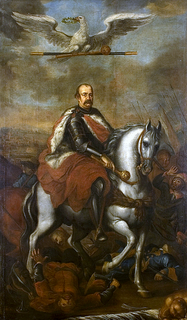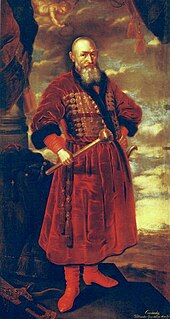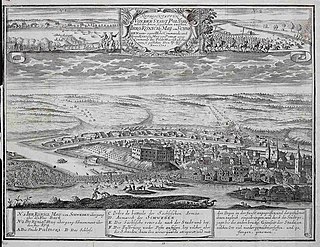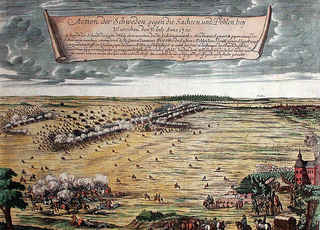 W
WThe Battle of Brest was a battle between Russian imperial forces and Polish rebels south-west of Brest, present-day Belarus, on 19 September 1794. It was part of the Kościuszko Uprising.
 W
WThe Battle of Byczyna, also known as the Battle of Pitschen, was the deciding battle of the 1587–1588 War of the Polish Succession, which erupted after two rival candidates were elected to the Polish throne. Both sides had rough parity in forces, with armies about 6,000 strong, divided roughly into half infantry and half cavalry. The battle was an overwhelming victory for the Polish-Swedish faction, led by the Swedish-born king-elect Sigismund III Vasa, over the army of his rival to the throne, Maximilian III, Archduke of Austria.
 W
WThe Battle of Cecora took place on October 19–20, 1595, during an expedition of Jan Zamoyski, of the Polish–Lithuanian Commonwealth, to Moldavia, as part of the Moldavian Magnate Wars.
 W
WThe Capture of Daugavgriva by Swedish forces in July 1608 occurred during the Polish–Swedish War (1600–1611).
 W
WThe Battle of Daugavgrīva took place on October 6, 1609 during the Polish–Swedish War (1600–1611).
 W
WThe 1659 Battle of Grudziądz took place in the Polish town of Grudziądz during the Swedish Deluge, around 29–30 August 1659. Polish forces were commanded either by hetman Jerzy Sebastian Lubomirski or general Krzysztof Grodzicki. The battle ended with the Polish victory, after a week-long siege; however much of the city was destroyed in a fire.
 W
WThe Battle of Khotyn or Battle of Chocim or Hotin War was a combined siege and series of battles which took place between 2 September and 9 October 1621 between a Polish-Lithuanian army with Cossack allies, commanded by the Grand Hetman of Lithuania Jan Karol Chodkiewicz, and an invading Ottoman Imperial army, led by Sultan Osman II, which was stopped until the first autumn snows. On 9 October, due to the lateness of the season and heavy losses - due to failed assaults on Commonwealth fortifications - the Ottomans abandoned their siege and the battle concluded with a stalemate, which is reflected in the treaty where some sections favour the Ottomans while others favoured the Commonwealth. Chodkiewicz died on 24 September 1621 shortly after concluding a treaty with the Turks.
 W
WThe Battle of Khotyn or Battle of Chocim or Hotin War was a battle on 11 November 1673, where the forces of the Polish–Lithuanian Commonwealth under hetman John Sobieski defeated Ottoman Empire forces led by Hussain Pasha. It reversed the fortunes of the previous year, when Commonwealth weakness led to the signing of the Treaty of Buchach, and allowed John Sobieski to win the upcoming royal election and become the king of Poland.
 W
WThe Battle of Krasnobród took place on 5–6 October 1672, during the Polish-Ottoman War. It was part of Jan Sobieski’s autumn expedition, aimed at the destruction of mounted Tatar units, which plundered southeastern provinces of the Polish–Lithuanian Commonwealth.
 W
WThe Battle of Lubieszów, occurred on April 17, 1577, was the most important battle in the two-year Danzig Rebellion fought between the forces loyal to the newly elected King Stefan Batory of the Polish–Lithuanian Commonwealth and the Commonwealth's richest city, Danzig (Gdańsk), following the city's refusal to accept the election of Batory as monarch of the Commonwealth which had taken place on December 15, 1575. The battle took place to the west of the town of Tczew (Dirschau), southeast of Gdansk on the left bank of the Vistula river, near Lubieszów Lake and the modern village of Lubiszewo Tczewskie. While it was not a decisive victory insofar as Gdansk itself was not taken and the war raged on, the city, having lost much of its wealthy citizenry, did finally to come to terms with the king at the end of the year.
 W
WBattle of Lwów or Battle of Lesienice refers to a battle between the armies of Polish–Lithuanian Commonwealth and Ottoman Empire that took place near the city of Lwów on August 24, 1675.
 W
WThe Battle of Magierów took place on 11 July 1657, during the period in Polish history known as the Swedish Deluge. Polish army commanded by Stefan Czarniecki, and supported by Crimean Tatars, defeated a Transilvanian-Cossack-Moldavian-Wallachian army of George II Rákóczi.
 W
WThe Battle of Mątwy was the biggest and bloodiest battle of the so-called Lubomirski Rokosz, a rebellion against Polish King John II Casimir, initiated by a magnate and hetman, Jerzy Sebastian Lubomirski. It took place on 13 July 1666 in the village of Mątwy, and ended in rebel victory. The royal army of the Polish–Lithuanian Commonwealth lost almost 4000 of its best and most experiences soldiers, who were murdered by Lubomirski's men. Rebel losses are estimated at approximately 200.
 W
WBattle of Mir was one of the first battles of the Polish–Russian War of 1792. It took place in the town of Mir, which is now part of Belarus on June 11, 1792.
 W
WThe Battle of Moscow was a series of two battles, which took place in Moscow, on September 1 and 3, 1612, during the Polish–Muscovite War (1605–18). Forces of the Polish–Lithuanian Commonwealth were commanded by Field Hetman of Lithuania, Jan Karol Chodkiewicz, while Russians were led by Dmitry Pozharsky. The battles ended in tactical Russian victory.
 W
WThe Battle of Mozhaysk was a series of battles at the final stage of the Polish-Muscovite War (1605-1618) on the western approaches to Moscow. The battle is part of the Moscow campaign of Wladyslaw IV. During months of fighting, the Russian armies managed to maintain their combat capability and prevent the rapid seizure of Moscow. However, the threat of encirclement forced the Russian troops to retreat, opening the way for the enemy to the capital.
 W
WThe Battle of Podhajce was fought in the town of Podhajce in the Polish–Lithuanian Commonwealth, and the area surrounding it as part of the Polish-Tartar War and the Great Turkish War. The army of the Polish–Lithuanian Commonwealth under John III Sobieski, totaling around 9,000 men defeated Tatar and Cossack forces under Petro Doroshenko and Adil Giray, which totaled around 35,000 men.
 W
WThe Battle of Praga took place on October 25, 1705 near the town of Warsaw, Poland during the fifth year of the Great Northern War. The Swedish army of more than 270 men assisted by approximately 140 soldiers from the Polish–Lithuanian Commonwealth under the command of Valentin Dahldorf defeated a combined Polish–Saxon–Russian force of about 5,000 men under Michał Serwacy Wiśniowiecki and Aleksandr Menshikov.
 W
WThe Battle of Pułtusk took place on April 21, 1703 in Pułtusk during the Great Northern War. The Swedish army under the command of Charles XII defeated the Saxon army under Adam Heinrich von Steinau.
 W
WThe 1587 Siege of Kraków took place between 14 October and 29 November 1587, after the contested 1587 Polish–Lithuanian royal election, which resulted in a double selection of opposing candidates - Zygmunt Waza was elected by the nobility on the 19th of August, while another faction of the gentry chose Maximilian III, Archduke of Austria, on the 22nd of August. Maximillian attempted to enforce his election by force, leading to the War of the Polish Succession (1587-1588), and in the course of the campaign besieged the city of Kraków.
 W
WThe Siege of Polotsk was a siege by forces of the Polish–Lithuanian Commonwealth under Stefan Bathory on the Russian-held city of Polotsk. Polotsk had been captured and heavily fortified by the Russians under Ivan the Terrible in 1563 because the river Dwina, which led to the key city of Riga, flowed through it. Hungarian soldiers, led by Caspar Bekes, Polish soldiers, led by Mikolaj Mielecki, and Lithuanian soldiers, led by Mikolaj Radziwill, converged at the Dzisna fortress, joined Bathory's men, and moved on to Polotsk, with a total force of about 42,000. Polotsk had three fortresses: the central one, nearby Strelec fortress, and the walled town of Zapolochie. The primary focus was on the central fortress: first with artillery, which failed because it only punctured the wooden walls, then with cannons, and eventually with fire. The Russians defended Polotsk with trenches and artillery, but after the Hungarian contingent captured Zapolochie, the Russians surrendered. After taking the city, Bathory's forces then moved to besiege Velikiye Luki.>
 W
WBattle of Skalat in 1657 was part of The Deluge.
 W
WThe siege of Smolensk lasted almost a year between 1632 and 1633, when the Muscovite army besieged the Polish–Lithuanian city of Smolensk during the war named after that siege. Muscovite forces of over 25,000 under Mikhail Borisovich Shein began the siege of Smolensk on 28 October. The Polish garrison under Samuel Drucki-Sokoliński numbered about 3,000. The fortress held out for nearly a year, and in 1633 the newly-elected Polish king Władysław IV organised a relief force. In a series of fierce engagements, Commonwealth forces gradually overran the Russian field fortifications, and by 4 October the siege had broken. Shein had become besieged in his camp, and began surrender negotiations in January 1634, capitulating around 1 March.
 W
WThe Siege of Toruń was one of the battles during the Swedish invasion of Polish–Lithuanian Commonwealth. It started on 2 July 1658 and ended on 30 December 1658. Swedish garrison capitulated and Toruń returned to Polish hands.
 W
WThe Battle of Trembowla, more popularly known as the Defence of Trembowla took place between September 20 – October 11, 1675, during the Polish-Ottoman War (1672-1676). Heroic resistance of Polish forces became a symbol, and was glorified and immortalised in the paintings of Franciszek Smuglewicz, Józef Peszka and Aleksander Lesser.
 W
WThe Battle of Cecora was a battle during the Polish–Ottoman War (1620–21) between the Polish–Lithuanian Commonwealth and Ottoman forces, fought from 17 September to 7 October 1620 in Moldavia, near the Prut River.
 W
WThe Battle of Warsaw was fought on 31 July 1705 near Warsaw, Poland, during the Great Northern War. The battle was part of a power struggle for the Polish–Lithuanian throne. It was fought between Augustus II the Strong and Stanisław Leszczyński and their allies. Augustus II entered the Northern war as elector of Saxony and king of the Polish–Lithuanian Commonwealth, and had formed an alliance with Denmark–Norway and Russia. Stanisław Leszczyński had seized the Polish throne in 1704, with the support of the Swedish army of Charles XII of Sweden. The struggle for the throne forced the Polish nobility to pick sides; the Warsaw Confederation supported Leszczyński and Sweden, and the Sandomierz Confederation supported Augustus II and his allies. The conflict resulted in the Polish civil war of 1704–1706.
 W
WThe Battles of Wenden were a series of battles for control of the stronghold of Wenden, in present-day Latvia, fought during the Livonian War in 1577 and 1578. Magnus of Livonia besieged the town in August 1577, but was deposed and replaced by Russian forces under Tsar Ivan IV, who eventually sacked the town and castle in what became a symbolic victory. Polish forces, however, re-captured the stronghold in November and beat back a Russian counter-attack in February 1578.
 W
WBattle of Wenden was a battle fought during the Polish–Swedish War (1626–1629), between Sweden and the Polish–Lithuanian Commonwealth on December 3, 1626 at Wenden in present-day Latvia. Swedish forces were led by Gustav Horn and Hans Wrangel. Lithuanian forces were led by Aleksander Gosiewski. The Swedes won the battle.